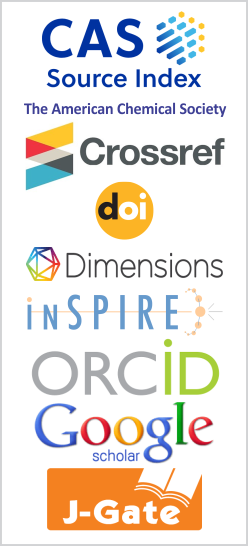Dissipation and Relative Entropy
DOI:
https://doi.org/10.26713/jamcnp.v8i2.1629Keywords:
Fluctuation theorem, Non equilibrium and irreversible thermodynamic, random processAbstract
It is shown that the total dissipative work is exactly given by the sum of two contributions. First by the relative entropy of probability of forward path and its time reversed path and second by the relative entropy of non equilibrium and equilibrium probability distribution at that time. The conclusion is supported using a simple model.
Downloads
References
D. Andrieux, P. Gaspard, S. Ciliberto, N. Garnier, S. Joubaud and A. Petrosyan, Entropy production and time asymmetry in nonequilibrium fluctuations, Physical Review Letters 98 (2007), 150601, DOI: 10.1103/PhysRevLett.98.150601.
C. Van den Broeck, Stochastic thermodynamics: A brief introduction, Proceedings of the International School of Physics “Enrico Fermi”, Volume 184: Physics of Complex Colloids, pp. 155 – 193, IOS Press Ebooks, DOI: 10.3254/978-1-61499-278-3-155.
V. Y. Chernyak, M. Chertkov and C. Jarzynski, Path-integral analysis of fluctuation theorems for general Langevin processes, Journal of Statistical Mechanics: Theory and Experiment 08 (2006), DOI: 10.1088/1742-5468/2006/08/P08001.
G. E. Crooks, Entropy production fluctuation theorem and the nonequilibrium work relation for free energy differences, Physical Review E 60 (1999), 2721, DOI: 10.1103/PhysRevE.60.2721.
G. E. Crooks, Nonequilibrium measurements of free energy differences for microscopically reversible Markovian systems, Journal of Statistical Physics 90 (1998), 1481 – 1487, DOI: 10.1023/A:1023208217925.
G. E. Crooks, Path-ensemble averages in systems driven far from equilibrium, Physical Review E 61 (2000), 2361, DOI: 10.1103/PhysRevE.61.2361.
M. Esposito and C. Van den Broeck, Second law and Landauer principle far from equilibrium, Europhysics Letters 95 (4) (2011), 40004, DOI: 10.1209/0295-5075/95/40004.
D. J. Evans, E. G. D. Cohen and G. P. Morriss, Probability of second law violations in shearing steady states, Physical Review Letters 71 (1993), 2401, DOI: 10.1103/PhysRevLett.71.2401.
G. Gallavotti and E. G. D. Cohen, Dynamical ensembles in nonequilibrium statistical mechanics, Physical Review Letters 74 (1995), 2694, DOI: 10.1103/PhysRevLett.74.2694.
P. Gaspard, Time-reversed dynamical entropy and irreversibility in Markovian random processes, Journal of Statistical Physics 117 (2004), 599 – 615, DOI: 10.1007/s10955-004-3455-1.
A. Gomez-Marin, J. M. R. Parrondo and C. Van den Broeck, Lower bounds on dissipation upon coarse graining, Physical Review E 78 (2008), 011107, DOI: 10.1103/PhysRevE.78.011107.
A. Gomez-Marin, J. M. R. Parrondo and C. Van den Broeck, The “footprints” of irreversibility, Europhysics Letters 82(5) (2008), 50002, DOI: 10.1209/0295-5075/82/50002.
M. Hattori and S. Abe, Path probability of stochastic motion: A functional approach, Physica A: Statistical Mechanics and its Applications 451 (2016), 198 – 204, DOI: 10.1016/j.physa.2016.01.053.
T. M. Hoang, R. Pan, J. Ahn, J. Bang, H. T. Quan and T. Li, Experimental test of the differential fluctuation theorem and a generalized Jarzynski equality for arbitrary initial states, Physical Review Letters 120 (2018), 080602, DOI: 10.1103/PhysRevLett.120.080602.
J. Horowitz and C. Jarzynski, Illustrative example of the relationship between dissipation and relative entropy, Physical Review E 79 (2009), 021106, DOI: 10.1103/PhysRevE.79.021106.
C. Jarzynski, Equilibrium free-energy differences from nonequilibrium measurements: A master-equation approach, Physical Review E 56 (1997), 5018, DOI: 10.1103/PhysRevE.56.5018.
C. Jarzynski, Fluctuation relations and strong inequalities for thermally isolated systems, Physica A: Statistical Mechanics and its Applications 552 (2020), 122077, DOI: 10.1016/j.physa.2019.122077.
C. Jarzynski, Nonequilibrium equality for free energy differences, Physical Review Letters 78 (1997), 2690, DOI: 10.1103/PhysRevLett.78.2690.
R. Kawai, J. M. R. Parrondo and C. Van den Broeck, Dissipation: The phase-space perspective, Physical Review Letters 98 (2007), 080602, DOI: 10.1103/PhysRevLett.98.080602.
J. Kurchan, Fluctuation theorem for stochastic dynamics, Journal of Physics A: Mathematical and General 31 (1998), 3719, DOI: 10.1088/0305-4470/31/16/003.
R. Landauer, Irreversibility and heat generation in the computing Process, IBM Journal of Research and Development 5 (1961), 183 – 191, DOI: 10.1147/rd.53.0183.
J. L. Lebowitz and H. Spohn, A Gallavotti-Cohen-Type symmetry in the large deviation functional for Stochastic dynamics, Journal of Statistical Physics 95 (1999), 333 – 365, DOI: 10.1023/A:1004589714161.
H. Qian, Mesoscopic nonequilibrium thermodynamics of single macromolecules and dynamic entropy-energy compensation, Physical Review E 65 (2002), 016102, DOI: 10.1103/Phys-RevE.65.016102.
F. Reif, Fundamentals of Statistical and Thermal Physics, McGraw-Hill, New York (1965).
U. Seifert, Entropy production along a Stochastic trajectory and an integral fluctuation theorem, Physical Review Letters 95 (2005), 040602, DOI: 10.1103/PhysRevLett.95.040602.
U. Seifert, From Stochastic thermodynamics to thermodynamic inference, Annual Review of Condensed Matter Physics 10 (2019), 171 – 192, DOI: 10.1146/annurev-conmatphys-031218-013554.
U. Seifert, Stochastic thermodynamics: Principles and perspectives, The European Physical Journal B 64 (2008), 423 – 431, DOI: 10.1140/epjb/e2008-00001-9.
K. Sekimoto, Stochastic Energetics, Lecture Notes in Physics Series, Springer-Verlag, Berlin — Heidelberg (2010), DOI: 10.1007/978-3-642-05411-2.
K. Sekimoto, Langevin equation and thermodynamics, Progress of Theoretical Physics Supplement 130 (1998), 17 – 27, DOI: 10.1143/PTPS.130.17.
S. Vaikuntanathan and C. Jarzynski, Dissipation and lag in irreversible processes, Europhysics Letters 87 (2009), 60005, DOI: 10.1209/0295-5075/87/60005.
Downloads
Published
How to Cite
Issue
Section
License
Authors who publish with this journal agree to the following terms:- Authors retain copyright and grant the journal right of first publication with the work simultaneously licensed under a CCAL that allows others to share the work with an acknowledgement of the work's authorship and initial publication in this journal.
- Authors are able to enter into separate, additional contractual arrangements for the non-exclusive distribution of the journal's published version of the work (e.g., post it to an institutional repository or publish it in a book), with an acknowledgement of its initial publication in this journal.
- Authors are permitted and encouraged to post their work online (e.g., in institutional repositories or on their website) prior to and during the submission process, as it can lead to productive exchanges, as well as earlier and greater citation of published work.




